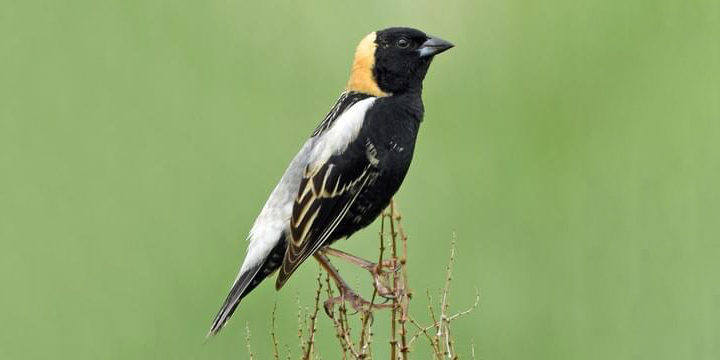Bird of The Week: Bobolink
SCIENTIFIC NAME: Dolichonyx oryzivorus
POPULATION: 9.7 million
TREND: Decreasing
HABITAT: Breeds in hay and fallow fields, meadows, and tallgrass prairie; winters in grasslands, marshes, and on cropland
The bubbling song of the Bobolink, which has inspired poets from Emily Dickinson to William Cullen Bryant, ushers in spring across grasslands of the northern United States and southern Canada. Unlike less-conspicuous grassland breeders such as the Eastern Meadowlark or Grasshopper Sparrow, the male Bobolink, with his flashy black-and-white breeding plumage, seems to be wearing a “backwards tuxedo.” No other North American songbird is black underneath and white on the back.
An Annual Change of Menu
The Bobolink’s species name oryzivorus means “rice-eating” and refers to this bird’s penchant for grains, particularly during migration and on wintering grounds. When on the move, Bobolink flocks can eat large quantities of grains, and the birds are often shot as agricultural pests, particularly on their wintering grounds. Bobolinks are known as “butter birds” in Jamaica, where the plumped-up migrants are sometimes harvested for food as they pass through that country.
Long-Distance Voyager
Like the Blackpoll Warbler and Red Knot, the Bobolink is a champion long-distance migrant, traveling roughly 12,000 miles round-trip to and from central South America each year. During its lifetime, a Bobolink may travel the same distance as four or five laps around the world!
After the breeding season, Bobolinks begin to gather in flocks and move to freshwater marshes and coastal areas to molt and fatten up before migrating. Male Bobolinks exchange their conspicuous breeding dress for plainer buff and brown plumage resembling that of females and immatures. In all plumages, Bobolinks can be identified by their stiff-looking, sharply-pointed tail feathers.
Most Bobolinks winter east of the Andes in the grasslands (or pampas) of southwestern Brazil, Paraguay, northern Argentina, and central Bolivia. Geolocator data revealed that Bobolinks often pause for several weeks in the grasslands of Venezuela, Colombia, or Bolivia before continuing on to wintering areas.
Migrating Bobolinks find refuge at the Barba Azul Nature Reserve, where ABC and Bolivian partner Asociación Armonía protect over 27,000 acres of habitat for the Critically Endangered Blue-throated Macaw and many other species.
“We record groups of 10 to 20 Bobolinks daily during November and December,” says Bennett Hennessey, who works both for Armonía and as ABC’s Brazil Conservation Program Coordinator. “Large groups of them migrate 350 miles farther south in Bolivia to the soy and corn crops in the department of Santa Cruz, where there are very large congregations throughout our summer.”
Soundtrack for Hay Fields and Meadows
The Bobolink breeds in native grasslands and agricultural fields across southern Canada and in the United States from eastern Washington and Oregon through the upper Midwest, to the northeastern states. Nesting occurs as far south as central Kansas, northern Kentucky, and the Appalachian foothills of West Virginia and Virginia.
Male Bobolinks arrive on the breeding grounds ahead of the females and compete for territories through fluttering, hovering flight displays and complex, rollicking, bubbly, twangy songs. The birds likely get their common name from the notes at the song’s crescendo. (One early interpretation was “Bob o’ Lincoln.”) Males also display from perches with tails spread and wings drooped to display large white shoulder patches, their bills pointed down to show off
After mating, the drably colored female builds her cup-shaped nest on the ground, well-hidden in dense vegetation. She alone broods the clutch of five to seven eggs. Bobolinks are polygynous, meaning that males may have several mates per breeding season. A female also may mate with many males (called polyandry), so a single Bobolink clutch may have multiple fathers.
Both parents feed the nestlings, sometimes with the assistance of a “helper,” a bird that may be offspring from the previous year or an adult that lost its brood. Young leave the nest about eight to 14 days after hatching and stay hidden until they are able to fly. Bobolinks raise only one brood per year.
Granivorous Ground-Gleaner
During the breeding season, Bobolinks eat seeds and a variety of larval and adult insects and spiders, as well as snails. Young birds are fed invertebrates, as they need the protein to grow quickly. This species feeds on the ground or low in vegetation. During migration and winter, Bobolinks become almost entirely granivorous (seed-eating), feeding on wild and domesticated rice, sorghum, oats, and other grains.
Help for Grassland Birds
The main reason for Bobolink declines is habitat loss, particularly due to early and repeated hay harvests. A 2019 study showed that grassland bird species such as the Bobolink, Dickcissel, and Henslow’s Sparrow experienced a 53-percent reduction in population — a loss of more than 720 million birds — since 1970.
Bobolinks are also vulnerable to pesticides, particularly on their wintering grounds, where they are sometimes intentionally poisoned and shot as agricultural pests. ABC is working to help the Bobolink and other grassland birds through our Pesticides program. We are fighting to block or restrict dangerous pesticides such as carbofuran and neonicotinoids that are widely used in agriculture, homes, and gardens. In addition, we advocate for key Farm Bill provisions such as the Conservation Reserve Program, which encourages grassland conservation on working farms.
SOURCE: American Bird Conservancy (abcbirds.org)


